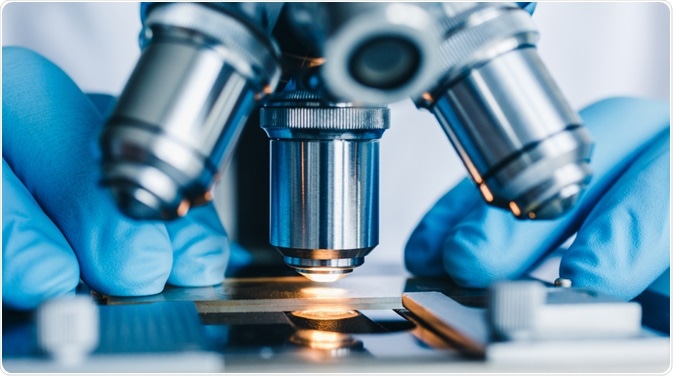In the field of super-resolution microscopy, single-molecule localization microscopy (SMLM) is a fast-evolving technique that allows researchers to study subcellular structures and the dynamics of single molecules at the nanoscale. SMLM works by isolating single fluorescent molecules from each other based on one or more of their distinguishing optical characteristics.
 Image Credit: Konstantin Kolosov / Shutterstock.com
Image Credit: Konstantin Kolosov / Shutterstock.com
With SMLM, super-resolution images of specimens with densely packed fluorophores are produced by localizing each fluorescent emitter to a high degree of precision. This involves statistically fitting a Gaussian function to the measurable distribution of photons.
Like any modern analytical technique, there are several variations of single-molecule localization microscopy. One of these is binding activated localization microscopy (BALM.)
What is BALM?
Nucleic acid stains show a strong enhancement of their fluorescence upon binding to double-stranded DNA. This property can be exploited to provide super-resolution imaging based on the localization of individual binding events. This makes both the dyes and DNA itself attractive prospects for highly localized staining to produce high-quality images with enhanced clarity of detail.
BALM is effectively a generalized concept in SMLM. By adjusting the chemical environment, the properties of both the dye and DNA (in DNA-binding dyes) can be properly controlled and modified, which in turn controls the fluorescence signal.
By controlling the chemical environment, DNA hybridization and melting becomes reversible, meaning that the process itself becomes more dynamic. A small number of DNA-binding dye signals are optically isolated at any one time, allowing for differences in structures to be identified with a high degree of precision.
The principle of BALM can be applied to other targets (for example, proteins), and even other types of dye.
Applications of BALM
There are several studies that have been carried out that utilize BALM to produce super-resolution images of various nanomolecular structures.
In 2011 a study by Ingmar Schoen and their team, published in Nano Letters, applied the principle of BALM to capture images of the organization of the E. Coli bacterial chromosome. Using the technique, they visualized structures with a resolution of ~14 nm and a spatial sampling of 1 nm. This was possible due to the dynamic labeling technique and optimization of fluorophore brightness.
Another study involving BALM was the observation of chromatin nanostructure based on fluctuations in DNA structure. The structural resolution anticipated by the study was ~50 nm, and by using transient dyes, they were able to observe highly detailed fluctuations in the nanostructure.
The team concluded that BALM could help to identify aberrations that occur in various pathological conditions, and has the potential to analyze differences in the different types of cell, developmental stages, and environmental stress conditions.
The technique has also been used to image amyloid fibrils and oligomers. A 2013 study by Jonas Ries and colleagues provided images of α-synuclein amyloid fibrils.
This study helped to throw light on the structures and processes involved with amyloid structure formation, which plays a role in various neurodegenerative conditions, including Alzheimer’s and Parkinson’s disease. It could also help in the design of therapeutic drugs that perturb amyloid structure formation.
Summary
In conclusion, BALM is a technique with the potential to be a game-changing technology in the study of nanomolecular structures and drug design for a wide variety of pathological conditions. It is a technique that lies at the cutting edge of the field of super-resolution microscopy, which is providing images of a superior quality to help to analyze structures that would otherwise be blurry and hard to distinguish.
Sources
Ries, J et al. (2013), Superresolution imaging of amyloid fibrils with binding-activated probes, ACS Chem. Neurosci Vol. 4 Issue 7 pgs. 1057-1061 https://doi.org/10.1021/cn400091m
Szczurek, A et al. (2017) Imaging chromatin nanostructure with binding-activated localization microscopy based on DNA structure fluctuations, Nucleic Acids Research Vol. 45, Issue 8, Page e56 https://doi.org/10.1093/nar/gkw1301
Schoen, I et al. (2011) Binding-activated localization microscopy of DNA structures Nano Letters Vol. 11 Issue 9 pgs. 4008-4011 https://doi.org/10.1021/nl2025954
Further Reading
- All Microscopy Content
- Advances in Fluorescence Microscopy
- Applications in Light Microscopy
- Electron Microscopy: An Overview
- Brief History of Microscopy
Last Updated: Jan 8, 2020

Written by
Reginald Davey
Reg Davey is a freelance copywriter and editor based in Nottingham in the United Kingdom. Writing for News Medical represents the coming together of various interests and fields he has been interested and involved in over the years, including Microbiology, Biomedical Sciences, and Environmental Science.
Source: Read Full Article
